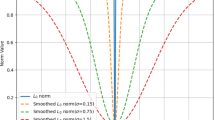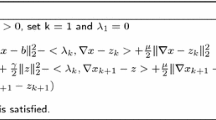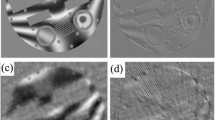Abstract
Purpose
An efficient algorithm for magnetic resonance (MR) image reconstruction is needed, especially when sparse sampling is employed to accelerate data acquisition. The aim of this paper is to solve the sparse MRI problem based on nonlocal total variation (NLTV) and framelet sparsity using the split Bregman algorithm. A new method was developed and tested in a variety of MR image acquisitions.
Methods
The proposed method minimizes a linear combination of NLTV, least square data fitting and framelet terms to reconstruct the MR images from undersampled \(k\)-space data. The NLTV and framelet sparsity are taken as the \(L_{1}\)-regularization functional and solved by using the split Bregman method. Experiments were conducted to compare the proposed algorithm with several different reconstruction methods, including the operator splitting algorithm, variable splitting method, composite splitting algorithm and its accelerated version called the fast composite splitting algorithm. A detailed evaluation study was done on the reconstruction of MR images which represent varying degrees of object structural complexity. Both qualitative visualization-based and quantitative metric-based evaluations were done.
Results
Numerical results on various data corresponding to different sampling rates showed the advantages of the new method in preserving geometrical features, textures and fine structures. The proposed algorithm was compared with previous methods in terms of the reconstruction accuracy and computational complexity with favorable results.
Conclusion
An efficient new algorithm was developed for compressed MR image reconstruction based on NLTV and framelet sparsity. The algorithm effectively solves a hybrid regularizer based on framelet sparsity and NLTV using the split Bregman method. NLTV makes the recovered image quality sharper by preserving the edges or boundaries more accurately, and framelets often improve image quality. The comparison with alternative method yielded results that demonstrate the superiority of the proposed algorithm for compressed MR image reconstruction.









Similar content being viewed by others
References
Candes EJ, Romberg J, Tao T (2006) Robust uncertainty principles: exact signal reconstruction from highly incomplete frequency information. IEEE Trans Inf Theory 52:489–509
Donoho D (2006) Compressed sensing. IEEE Trans Inf Theory 52(4):1289–1306
Boyd S, Vandenberghe L (2004) Convex optimization. Cambridge University Press, Cambridge
Nocedal J, Wright S (2006) Numerical optimization, 2nd edn. Springer, New York
Lustig M, Donoho D, Pauly J (2007) Sparse MRI: the application of compressed sensing for rapid MR imaging. Magn Reson Med 58:1182–1195
Ma S, Yin W, Zhang Y, Chakraborty A (2008) An efficient algorithm for compressed MR imaging using total variation and wavelets. In: Proceedings of CVPR
Yang J, Zhang Y, Yin W (2010) A fast alternating direction method for TVL1-L2 signal reconstruction from partial fourier data. IEEE J Sel Topics Signal Process 4(2):288–297 (Special Issue on Compressive Sensing)
Huang J, Zhang S, Metaxas D (2011) Efficient MR image reconstruction for compressed MR imaging. Med Image Anal 15:670–679
Compton R, Osher S, Bouchard L (2012) Hybrid regularization for MRI reconstruction with static field inhomogeneity correction. In: International symposium on biomedical imaging, pp 650–655
Dobson DC, Santosa F (1996) Recovery of blocky images from noisy and blurred data. SIAM J Appl Math 56:1181–1198
Chambolle A, Lions PL (1997) Image recovery via total variation minimization and related problems. Numer Math 76:167–188
Meyer Y (2001) Oscillating Patterns in Image Processing and Nonlinear Evolution Equations: The Fifteenth Dean Jacqueline B. Lewis Memorial Lectures, vol 22 of University Lecture Series, American Mathematical Society, Boston, MA, USA, 85, 92, 123, 130, 131
Osher S, Burger M, Goldfarb D, Xu J, Yin W (2005) An iterative regularization method for total variation-based image restoration. Multiscale Model Simul 4:460–489
Tian Z, Jia X, Yuan K, Pan T, Jiang SB (2011) Low dose CT reconstruction via edge preserving total variation regularization. Phys Med Biol 56(18):5949–5967
Daubechies I, Han B, Ron A, Shen Z (2003) Framelets: MRA-based constructions of wavelet frames. Appl Comput Harmon Anal 14:1–46
Cai JF, Osher S, Shen Z (2010) Split Bregman methods and frame based image restoration. Multiscale Model Simul 8(2):337
Goldstein T, Osher S (2009) The split Bregman method for \(L_{1}\)-regularized problems. SIAM J Imaging Sci 2(2):323–343
Chaari L, Pesquet JC, Benazza-Benyahia A, Ciuciu P (2011) A wavelet-based regularized reconstruction algorithm for SENSE parallel MRI with applications to neuroimaging. Med Image Anal 15(2):185–201
Boyer C, Ciuciu P, Weiss P, Meriaux S (2012) HYR2PICS: hybrid regularized reconstruction for combined parallel imaging and compressive sensing in MRI. In: International symposium on biomedical, imaging, pp 66–69
Chaari L, Mriaux S, Badillo S, Pesquet J-Ch, Ciuciu P (2013) Multidimensional wavelet-based regularized reconstruction for parallel acquisition in neuroimaging, pp 1–38
Peyre G, Bougleux S, Cohen L (2008) Non-local regularization of inverse problems. In: Computer vision-ECCV 2008, vol 5304 of, Lecture Notes in Computer Science, pp 57–68
Gilboa G, Osher S (2008) Nonlocal operators with applications to image processing. Multiscale Model Simul 7:1005–1028
Zhang X, Burger M (2010) Bregmanized nonlocal regularization for deconvolution and sparse reconstruction. SIAM J Image Sci 3:253–276
Lou Y, Zhang X, Osher S, Bertozzi A (2010) Image recovery via nonlocal operators. J Sci Comput 42:185–197
Gopi VP, Palanisamy P, Wahid KA, Babyn P (2013) MR image reconstruction based on iterative split Bregman algorithm and nonlocal total variation, J Comput Math Method Med 2013:1–16
Liang D, Wang H, Chang Y, Ying L (2011) Sensitivity encoding reconstruction with nonlocal total variation regularization. Magn Reson Med 65:1384–1392
Velikina JV, Alexander AL, Samsonov A (2012) Accelerating MR parameter mapping using sparsity-promoting regularization in parametric dimension. Magn Reson Med. doi:10.1002/mrm.24577
Knoll F, Clason C, Bredies K, Uecker M, Stollberger R (2012) Parallel imaging with nonlinear reconstruction using variational penalties. Magn Reson Med 67:34–41
Knoll F, Schultz G, Bredies K, Gallichan D, Zaitsev M, Hennig J, Stollberger R (2013) Reconstruction of undersampled radial PatLoc imaging using total generalized variation. Magn Reson Med 70(1):40–52
Bregman L (1967) The relaxation method of finding the common points of convex sets and its application to the solution of problems in convex optimization. USSR Comput Math Math Phys 7:200–217
Yin W, Osher S, Goldfarb D, Darbon J (2008) Bregman iterative algorithms for \(\text{ L }_{1}\)-minimization with applications to compressed sensing. SIAM J Imaging Sci 1:143–168
He L, Chang TC, Osher S (2005) MR image reconstruction from sparse radial samples by using iterative refinement procedures. In: Proceedings of the 13th annual meeting of ISMRM, p 696
Wang Y, Yin W, Zhang Y (2007) A fast algorithm for image deblurring with total variation regularization, CAAM technical report TR07-10. Rice University, Houston
Selesnick I (2004) Symmetric wavelet tight frames with two generators. Appl Comput Harmon Anal 17(2):211–225
Shen Z (2010) Wavelet frames and image restorations. In: Proceedings of the international congress of mathematicians, Hyderabad, India
Ron A, Shen Z (1997) Affine systems in \(L_{2}(\mathbb{R}^{d})\): the analysis of the analysis operator. J Funct Anal 148(2):408–447
Dong B, Shen Z (2010) MRA based wavelet frames and applications. IAS Lecture Notes Series, Summer Program on The Mathematics of Image Processing, Park City Mathematics Institute
Setzer S (2008) Split Bregman algorithm. Douglas-Rachford splitting and frame shrinkage. Technical report
Wang Z, Bovik AC, Sheikh HR (2004) Image quality assessment: from error visibility to structural similarity. IEEE Trans Image Process 13(4):600–612
Zhang L, Zhang L, Mou X, Zhang D (2011) FSIM: a feature similarity index for image quality assessment. IEEE Trans Image Process 20(8):2378–2386
Acknowledgments
The authors would like to thank the Government of Canada for the financial support through Commonwealth Scholarship 2011-12 for this research work.
Conflict of interest
The authors declare that they have no conflict of interest.
Author information
Authors and Affiliations
Corresponding author
Appendix
Appendix
\(L_{2}\)-Norm
The most popular of all norm is the \(L_{2}\)-norm. It is used in almost every field of engineering and science as a whole. Following the basic definition, \(L_{2}\)-norm is defined as
\(L_{2}\)-norm is well known as a Euclidean norm, which is used as a standard quantity for measuring a vector difference. As in \(L_{1}\)-norm, if the Euclidean norm is computed for a vector difference, it is known as a Euclidean distance:
Image gradient \(\nabla \)
Image gradient is a directional change in the intensity or color in an image. Image gradients may be used to extract information from images. The gradient of an image is given by the formula
where \(\frac{\partial f}{\partial x}\widehat{x}\) is the gradient in the \(x\) direction and \(\frac{\partial f}{\partial y}\widehat{y}\) is the gradient in the \(y\) direction.
Rights and permissions
About this article
Cite this article
Gopi, V.P., Palanisamy, P., Wahid, K.A. et al. MR image reconstruction based on framelets and nonlocal total variation using split Bregman method. Int J CARS 9, 459–472 (2014). https://doi.org/10.1007/s11548-013-0938-z
Received:
Accepted:
Published:
Issue Date:
DOI: https://doi.org/10.1007/s11548-013-0938-z




